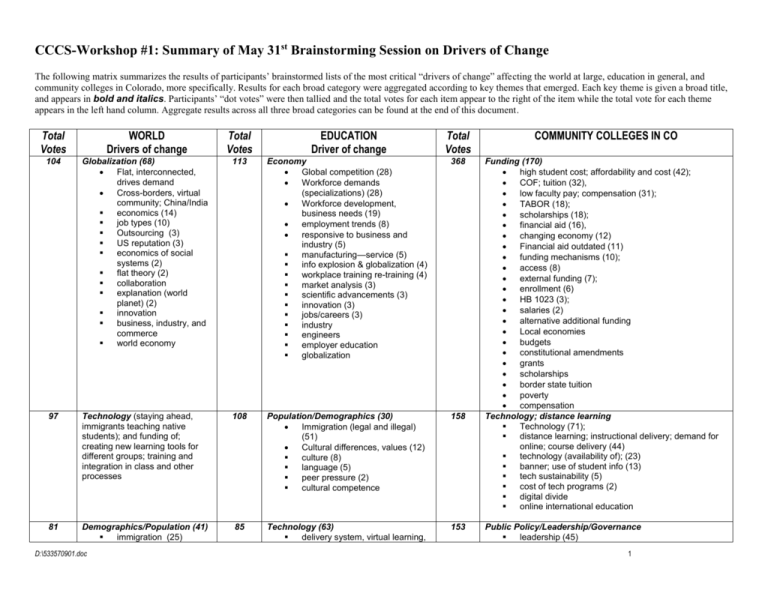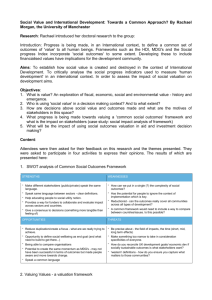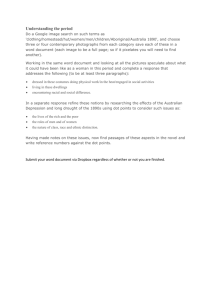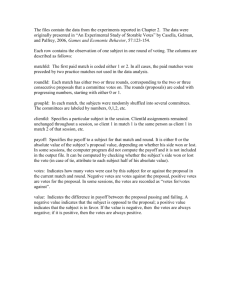CCCS-Workshop #1: Summary of May 31st Brainstorming Session
advertisement

CCCS-Workshop #1: Summary of May 31st Brainstorming Session on Drivers of Change The following matrix summarizes the results of participants’ brainstormed lists of the most critical “drivers of change” affecting the world at large, education in general, and community colleges in Colorado, more specifically. Results for each broad category were aggregated according to key themes that emerged. Each key theme is given a broad title, and appears in bold and italics. Participants’ “dot votes” were then tallied and the total votes for each item appear to the right of the item while the total vote for each theme appears in the left hand column. Aggregate results across all three broad categories can be found at the end of this document. Total Votes WORLD Drivers of change Total Votes EDUCATION Driver of change Total Votes 104 Globalization (68) Flat, interconnected, drives demand Cross-borders, virtual community; China/India economics (14) job types (10) Outsourcing (3) US reputation (3) economics of social systems (2) flat theory (2) collaboration explanation (world planet) (2) innovation business, industry, and commerce world economy 113 Economy Global competition (28) Workforce demands (specializations) (28) Workforce development, business needs (19) employment trends (8) responsive to business and industry (5) manufacturing—service (5) info explosion & globalization (4) workplace training re-training (4) market analysis (3) scientific advancements (3) innovation (3) jobs/careers (3) industry engineers employer education globalization 368 97 Technology (staying ahead, immigrants teaching native students); and funding of; creating new learning tools for different groups; training and integration in class and other processes 108 Population/Demographics (30) Immigration (legal and illegal) (51) Cultural differences, values (12) culture (8) language (5) peer pressure (2) cultural competence 158 81 Demographics/Population (41) immigration (25) 85 Technology (63) delivery system, virtual learning, 153 D:\533570901.doc COMMUNITY COLLEGES IN CO Funding (170) high student cost; affordability and cost (42); COF; tuition (32), low faculty pay; compensation (31); TABOR (18); scholarships (18); financial aid (16), changing economy (12) Financial aid outdated (11) funding mechanisms (10); access (8) external funding (7); enrollment (6) HB 1023 (3); salaries (2) alternative additional funding Local economies budgets constitutional amendments grants scholarships border state tuition poverty compensation Technology; distance learning Technology (71); distance learning; instructional delivery; demand for online; course delivery (44) technology (availability of); (23) banner; use of student info (13) tech sustainability (5) cost of tech programs (2) digital divide online international education Public Policy/Leadership/Governance leadership (45) 1 aging population (7) migration/immigration (6) language (2) population growth online (9) technology & integration (7) digital divide (4) instructional delivery (2) legislation; policy audit needed (need clarity here, consistency, consensus) (21) mission clarification (defined role and scope of mission, different missions, changing mission); “all things to all people” (20) governance of higher education (18) political climate (11); politics (10) constitutionalize ed to students & employees (8) 4 year college policies (8) Succession planning (5) accountability (4) accreditation changes (2) regulations (1) unfunded mandates conflicting mandates legal issues 4 year institutions Systemic foundation vision Structure of system in future Local control Institutional research 73 Environment Energy, fuel (19) alternative energy (15) environmental problems (14) climate change; global warming (8) water, oil (6) natural resources (4) agriculture; food source (3) food production (2) nuclear power (2) natural disasters (1) 84 Finances (personal and public) Funding (36) Cost; affordability (33) economy (4) enrollment trends (4) $$ tax and wealth level of students (3) resource availability (2) income disparity (2) money financial aid 148 Flexibility; Agility (entrepreneurialism) , adaptability responsiveness; flexibility; adaptability (55) competitiveness, competition (39) cooperation (14) capacity limitations; human capacity (9) scheduling (7) competition (inter); cccs system; Competition proprietary, independence (14) compete (external) (5) customization; personalization (3) individualized flexibility (2) balance between college and statewide interests change in # of colleges local control 62 Economics; Economic disparity (many dimensions); haves, havenots (42) job types (10) wealth/economy (5) economic disparity (many dimensions), haves & have nots (3) poverty (2) standard of living disparate housing 75 Education System Quality Issues under-education, college readiness, un-preparedness, remediation (26) K12 quality; (achievement gap; teaching to the test; graduation rates) (14) P20 (10) Seamless process (8) Retention & graduation (7) requirements for 12th grade (4) 130 Economic development workforce demands; industry trends (56) responsive to business and industry (19) industry partnerships & niche markets; partnerships (18) globalization (11) job opportunities (10) job placement (8) work with industry (3) CO imports its workforce (2) low unemployment (1) D:\533570901.doc 2 5th year programs (5) Adult remediation (1) K12 labor unions Curricular congruence and horizontal alignment Expectations in education demand for community education (1) retraining; workforce (1) voc-tech costs career development centers 45 Political power shifts; politics Political power shifts (34) leadership (4) ideological differences (3) religion (4) 59 Public Policy Govt., regulation (local, state, national) (16) Access (18) quality/accountability, (CSAP, NCLB) (11) leadership (6) government oversight & accountability (5) effective management & evaluation (3) 113 College Readiness/Remediation Unprepared students; lack of preparation; academically unprepared; education standards and expectations; quality of education & priorities; student success; Colorado paradox (69) retention (18) remediation (12) # of HS graduates; graduation rates (6) ESL (6) student participation patterns (2) enrollment fluctuations 37 War, Terrorism, Conflict (34) homeland security (2) xenophobia (1) 32 Recruitment & Retention of Faculty Recruitment, retaining faculty & administration (13) Compensation, merit-based (9) Aging workforce (6) Quality teachers; qualified teachers (4) professional development # of educators 103 Demographics, Student Population Diverse student population, multiculturalism (77) immigration (13) language barriers (6) melting pot (4) Generational divide (3) diversity language gender shift 16 Health risks (9) health and disease (2) pandemic (3) infections (2) global health 28 Public Perception/Public Relations Parental buy-in; societal buy-in (12) Societal values (8) attitude and reputation; public perception (8) Voter turnout 75 13 Education (13) Skill levels 25 Customization Individualization (9) multiple careers in a lifetime (7) custom education/privatization (6) individualized flexibility (3) 65 Public Perception & Community Support Image of CCCS/community college; PR, public perception (25) marketing the college; outreach (18) political climate (9) value of education (6) community relationships (5) public awareness of the issues (4) communication (3) relevance (3) reputation (2) State Geography rural/urban, geographical barriers (35) urban vs. rural (13) community demand (9) local population growth (8) D:\533570901.doc 3 increased privatization 13 Culture Family values; social values (5) cultural blending (5) Family (3) 12 Politics 57 Recruit and Retain Quality Staff Recruit and retain faculty (29) Aging workforce; retirements (16) Compensation, relevant reward system (7) qualified staff (4) PERA (1) Increase in full time faculty 9 Infrastructure Transportation (5) Mobility (4) 4 Mental & emotional issues Health care (6) Security issues 50 P20 agenda/continuity P20 system; P20 agenda, continuity (17) K-12 policies (16) K12 content standards (7) removing the silos of education (4) education gap (3) Disconnect with K-12 and universities seamless transfer/alignment (3) communication and cooperation across colleges; transfer articulation 7 Peace (7) 37 Collaboration and Partnerships partnerships (17) business partners (9) partnerships with communities (8) collaboration (between colleges) (3) 4 Gov. ownership of land 28 Student Services (5) transfer, advising, counseling (11) social activities (5) health services (clinical sites for health) (5) mentoring (2) linguistic center special needs; fragile students 3 Communication (3) information/media 13 Facilities Issues facilities/infrastructure (7) security (6) 1 Health care, medical advances Life expectancy Public health Biomedical research 13 Curriculum Consistent (10) Lifelong learning (3) learning styles service-learning Multiple careers in a lifetime D:\533570901.doc 4 Aggregate Results across All Three Broad Categories Some themes appear across all three broad categories. To gain a sense of the aggregate perception of the most critical drivers of change affecting community colleges, votes across all categories have been tallied and appear, below. Based on the results, the top ten drivers of change among participants included: 1. Funding and Finance issues (Total Dot Votes = 452) 2. Globalization and the Economy (Total Dot Votes = 409) 3. Technology (Total Dot Votes = 340) 4. Population and Demographic Changes (Total Dot Votes = 292) 5. Politics, Political Shifts, Public Policy, Leadership & Governance Issues (Total Dot Votes = 269) 6. Systemic Education Issues, Quality of Education (and preparedness of students) (Total Dot Votes = 251) 7. Flexibility, Adaptability, Customization, & Individualization (Total Dot Votes = 173) 8. Public Perceptions & Public Relations (Total Dot Votes = 103) 9. Recruitment & Retention of Faculty and Administration (Total Dot Votes = 89) 10. Environmental Issues (Climate change, energy, etc.) (Total Dot Votes = 75) D:\533570901.doc 5







